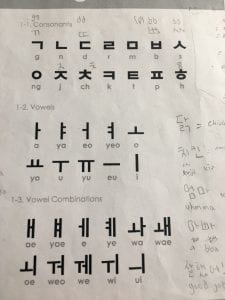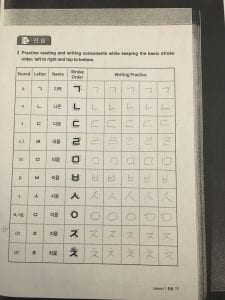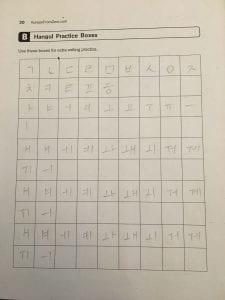Progress Report
As per the suggestion of my mentor, over the past two weeks I have been focusing on memorizing the Korean alphabet. Similar to English, Korean also has an alphabet used to spell out various words and phrases. The Korean alphabet can be split into three categories: consonants, vowels, and complex vowels. Each piece of the alphabet has a unique sound (shown in picture 1.1). In order to practice the Korean alphabet Ms. Kim also gave me character writing grids (shown in picture 1.2). These grids helped with the neatness of my characters, and also aided in my process of memorization through visual learning. As I wrote the character, I would also say the pronunciation out loud. This is done when learning the alphabet to create an association between a character and that character’s pronunciation.
Last week, Ms. Kim requested that I narrow down my objectives to be more specific for each meeting. My new goal for our next meeting is to have learned how to count from 1-50 in both pure Korean and Sino-Korean. As well, I will review my knowledge of the Korean alphabet and become more used to writing words. When I revealed this goal, Ms. Kim said that “even [the] native speaking students in her classes [would] mix up the numbers (in Korean) past 50.” As well, she said that the pure Korean number system is “harder to learn” because there’s more memorization required in the tens’ columns.
In our meeting earlier this morning, Ms. Kim started to teach me how to write some Korean words. First, she asked me to write out my name phonetically in Korean. I had some struggles while writing my name out, as I still haven’t developed a complete grasp of the alphabet. We continued to write more words throughout most of the meeting.
Picture 1.1 This is the Korean alphabet resource which Ms. Kim gave me during our first meeting:
Picture 1.2 These are the Korean writing grids which Ms. Kim gave me during our first meeting:
How to Have a Beautiful Mind
How to be Interesting
There weren’t many places where I felt this chapter related to the meetings between my mentor and I. Many of our conversations revolve around the foundations of the Korean language. There isn’t much room for alternatives or possibilities because the Korean alphabet and how to write words are already established concepts. But there are still some conversations that include “making connections [involving] possibilities, alternatives, and speculation (48).” A lot of the possibilities in our conversations surround my goals and how far I want to go with learning Korean this year (specifically what possibilities to explore next). I find conversations with Ms. Kim to be very interesting because she constantly draws on unique personal experiences and creates connections to the conversation at hand. These personal experiences are relatable and offer a sense of familiarity.
How to Respond
In this chapter, Edward De Bono states that “any speaker wants to communicate and to be understood, so no one minds being asked to repeat or to clarify something (55).” This has proven to be true within my conversations with Ms. Kim. She always asks if I have any questions or need clarification for new concepts I learn, which is very helpful for when/if I’m ever confused in our conversations. Edward De Bono also mentions that “examples and stories that fin in with what is being discussed add life and reality to any conversation (57).” As I mentioned earlier, Ms. Kim shares many anecdotes during evidence which add dimension to conversations. I find that this form of responding to a conversation comes with life experience, as you experience more relevant stories to draw upon. Contributing to conversations and becoming a more interesting person will be a long journey. There are many skills that I can work on, and there are some which I can’t control at the moment. Skills such as supporting a conversation is something I can build upon, but skills such as connecting life stories and personal experiences will only come naturally as I experience more in the future.
See you next time – Brian Cheng



